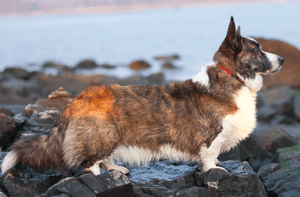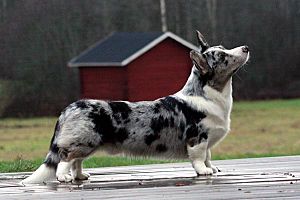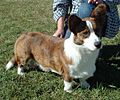Cardigan Welsh Corgi facts for kids

Brindle and white Cardigan Welsh Corgi
|
||||||||
| Common nicknames | Cardigan CWC Cardi |
|||||||
|---|---|---|---|---|---|---|---|---|
| Origin | Wales | |||||||
|
||||||||
| Domestic dog (Canis lupus familiaris) | ||||||||
The Cardigan Welsh Corgi is a type of dog breed that comes from Wales. It's one of two kinds of Welsh Corgis; the other is the Pembroke Welsh Corgi. This breed is very old, one of the oldest from the British Isles. Cardigan Welsh Corgis are known for being super loyal pets. They can live in many different places. These dogs love to play and learn new things.
Contents
History of the Cardigan Corgi
For a while, the Pembroke and Cardigan Welsh Corgis were seen as the same breed. This was by The Kennel Club in Britain in 1925. But in 1935, they were officially called separate breeds.
A club for Corgi lovers started in December 1925 in Carmarthen, South Wales. People there liked the Pembroke Corgi more. So, a year later in 1926, a club just for Cardigan fans began. Both groups worked hard to make sure their breeds looked and acted a certain way. They did this through careful breeding.
In 1928, both Corgi types were officially recognized. They were grouped together as "Welsh Corgis." Then, in 1934, they were finally recognized as two different breeds. This meant they could be shown separately in dog shows.
Some people think both Corgi breeds came from a line of northern spitz-type dogs. Others believe they came from the Teckel family of dogs. This family also includes Dachshunds.
The word "corgi" comes from the Welsh words cor gi. This means "dwarf dog." The breed used to be called "yard-long dog" in Welsh. Today's name comes from their home area: Ceredigion, which is "Cardigan" in Welsh.
About the Cardigan Corgi
The Cardigan is a long, low dog. It has upright ears and a tail that looks like a fox's brush.
These dogs were first used to guard farms. Over time, they learned to herd cattle and do many other jobs. Even today, they are great at herding, working, and guarding. They also make wonderful companions. The old American Kennel Club standard called them an "Alsatian on short legs." The Cardigan's tail is long. This is different from the Pembroke Welsh Corgi, whose tail can be short or naturally bobbed.
Cardigans have a double coat, which means they have two layers of fur. They come in many colors. These include red, sable, or brindle shades. They can also be black, with or without tan, brindle, or blue merle markings. They often have white fur on their neck, chest, legs, and muzzle. This is called the "Irish pattern."
An average Cardigan is about 10 to 13 inches (25 to 33 cm) tall at the shoulder. Males usually weigh 30 to 38 pounds (14 to 17 kg). Females weigh 25 to 34 pounds (11 to 15 kg). Cardigans usually live for 12 to 16 years. A litter of puppies usually has four to six babies.
Cardigan Corgi Health
The most common reasons for Cardigan Corgis to pass away are cancer, old age, and nerve problems.
Cardigan Welsh Corgis can sometimes get a condition called Canine Intervertebral Disc Disease (IVDD). This is because Cardigans are a dwarf breed. Dwarf breeds often have problems with their spinal discs. This disease is also common in Dachshunds.
Cardigan Corgi Temperament
Cardigan Welsh Corgis are very smart, active, and athletic dogs. They love to compete in dog sports. These include dog agility trials, obedience, showmanship, flyball, and tracking events. They also have strong herding instincts. These instincts can be tested in special non-competitive tests. Corgis with good herding instincts can be trained for herding competitions.
- Cardigans are excellent companion animals. They are loving and loyal to their families.
- They are good at competitive events like sheepdog trials and rally obedience.
- Even though they are small, they can be good guard dogs.
See also
 In Spanish: Corgi galés de Cardigan para niños
In Spanish: Corgi galés de Cardigan para niños











